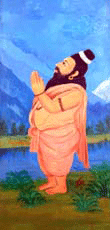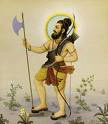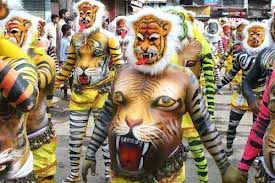
In Vadakkan kalaris these are known in the form of Vadivu or stances,poses or forms and in Thekkan kalaris these animal techniques are used in attacking on the various vital spots of the body, for locking an opponent, or used in various stepping moves for self defence.
LEGENDARY LORD PARASURAMA

Our ancient culture contains valuable knowledge from the 'Vedas' and 'Upanishads'The Hindu mythology has it that 'Brahma' - the lord of creation taught king 'Pridhu' how to use weapons. It is through him this art of weaponery spread throughout in the world.
KALARIPAYAT SPREAD TO CHINA AND JAPAN

There is evidence in the Indian History that the son of 'King Suganda' who received training from an old Master known as 'Prajnatra', who later on adopted Buddhism, and was known in the name 'Bodhidharma' or 'Ta Mo' in chinese, who went to south china, ruled by Emperor Liang Wu Ti. Later he moved to the north of china to Wei and settled at the Shaolin Temple in Honan province to preach Buddhism in 520 A.D. He was also known as 'Daruma Taishi'. He spend almost 9 years there teaching the young Monks who were weak and lazy for the tough form of Meditation. The proverb 'Sound Mind in a sound Body' has importance in this context. Bodhidharma trained the Chinese Monks in Eighteen Excercises or branches of study also known as 18 Adavus in malayalam language, and this is how Kalaripayat spread to china. The chinese called 'Kalaripayat' in the name of 'Kung-Fu' which means 'Man learning Martial-Art'. The Monks practiced this Martial-Art inorder to Safe-guard their Shaolin Temple from the invasion of enemy clans or Kings. Still today you may find on the walls of Shaolin Temple, paintings of dark-coloured Indian Monks practicing various Weapons with light skinned chinese Monks which itself is an evidence of the Indian presence in China. Also the disciple of Sage Agasthya, named Sage bhogar or Bhogar Muni, had been to china 3 times and had disciples in china. There he taught chinese students who translated the Indian Martial-art and herbal treatment theoris of Tamil-based Siddha-Medicine, which is now known in Books with Chinese names. The Yogis of India Knew the technique of making All these knowledge & techniques are now becoming extinct every generation. If you need to learn more on the secret theory of making beads out of mercury, its miraculous uses or using it for health aspects, you need to contact me personally.
From here the Kalaripayat Martial-art spread to Japan during the China-Japan war. Some changes were made by Japanese to the original Kalaripayat writing, which were now in Chinese and this came to be known as 'Ju-jitsu', which also contained the Marma or Vital spot techniques. When many masters curtailed the Vital-points and dangerous techniques from it, it took to another form known as 'Judo'. Judo got popular in the Olympics as a sport form. But Kalaripayat still remains in its original state inspite of the ravages of the time. Also many Tamil literatures which were translated in to Chinese earlier were carried to . Many of the scriptures were transmitted to disciples orally and hand-written by them, which were later transferred by word of mouth to there disciples.
BRITISH RULE IN INDIA AND THE DECLINE OF THE MARTIAL-ART

In olden times of battle, the bow and arrow used with the power of Mantras was considered as the best (Uttamam) type of weapon. Types of arrows used in the epics Mahabharatha and Ramayana were Nagastra(Snake form arrows), Brahmastra which had treamendous Magical powers incorporated to the arrows,using the power of mind. Also various arrow=head to suit various situations like cutting the hand or neck, sending messages etc were also used.
With the comming of British rule in India, the latest weapons like Guns and Cannons came in to the scene which could be used from far distance with accuracy at the opponent. Slowly the weapon fighting and empty-hand techniques started to decline with the appearance of ammunitions like bombs and new type of arms. Also the British put restrictions to the practice of Kalarippayat in Kerala. But few Martial-art Masters safe-guarded the Martial-art live in there minds and started training after the British rule declined in India. Some of them recorded the art descriptions and use of marma techniques in palm leaf scriptures for the future generations to come. But this was secretly and jealously guarded in many old Hindu families of Kerala and Tamilnadu. Others gave it a new dance form, a kind of stage dramas using sword & shield known as 'Chavittu-Nadakam', and Puli-kali emerged and the art was kept alive, which is still in practice in various parts of kerala as a traditional art form.
CHAVITTU-NADAKAM

'Chavitu Natakam' is a dance drama in which the stamping of leg(chavittu) is used on the stage by the artist, and it is popular among the Christians of kerala. This art form originated among the Latin catholics during the early days of Portuguese visit to India. The scholars 'Chinnathambi Annavi' was a tamilian and 'Vedanayakam pillai', who lived in the 16th century almost 400 years ago, are the pioneers who evolved this form of dance. In tamil 'Annavi' means 'Asan' or 'Guru'. In olden times the christians were not allowed by the churches to carry sword & shield within the church as they practiced kalaripayat. So they devised the Martial-art to a dance form. Also Since Kalaripayat martial art was banned from being practiced by the british invaders, many of these masters converted the movements of kalaripayat to this art form to keep it alive from the ravages of time. The theme of the drama are generally heroic tales from the Christian lore. The colourful costumes remind the Greek roman soldiers and early European kings. Infuluence of opera and Keralite Martial art form Kalaripayat is visible in the movements with the performer sometimes weilding swords and moving in rhythmic way along with traditional tamil or malayalam songs. The use of western instruments like violin and other native instruments like harmonium, flute, chenda, padathaberu, madalam, gongs, tabala etc are also used.
PuliKali Dance Form

Similarly the 'Puli Kali' dance form is also was devised to keep alive the Martial-art secret live during the british times. Puli means Leopard or Tiger & 'Kali' means Play or dance in Malayalam language. Puli kali is also known as 'Kaduvakali' and it is a colorful folk art performed in Kerala during the Onam season. It is performed by trained artists to entertain people on Onam festivity, during the annual harvest festival, On the (Nalaam Onam) 4th day of Onam celebrations. Performing artist painted like tigers or leapords and hunters dressed in bright yellow, red, or black dance to the rhythm of instruments like 'Udukku' and 'Thakil'. Literal Pulikali means the 'play of the tigers' and the performance revolve around the theme of tiger hunting. This folk art is mainly practiced in Thrissur district of Kerala, at Swaraj Ground on the 4th day of Onam, where Pulikali troupes from all over the district assemble to display their skills. The festival attracts thousands of people to theThrissur city. The origin of Pulikali dates back to almost 200 years, when the Maharaja Rama Varma Sakthan Thampuran, the then Maharaja of Cochin, is believed to have introduced this folk dance system, who wanted to celebrate Onam with a dance that reflected the wild spirit of the forest. Later the Muslim soldiers of the British Army stationed in Thrissur in the army cantonment area (Pattalam Road) also used to celebrate this folk art with great enthusiasm. They popularised this folk dance with steps and body language similar to the moves of a tiger being chased by a hunter. This was also known as 'Pulikkettikali' which was greatly enjoyed by the local people. Pulikali is held at Thrissur in memory of this eventbr>
Check Fees details & Enroll for Kalaripayat, Stick, Weapons, Marma-Sastra courses
CONTACT ADDRESS:
MATHEW GURUKKAL, BALI KALARI,
OPP: SHINES BLDG, EAST OF IRON-BRIDGE,
KOLLAM - 691 001, KERALA STATE, SOUTH-INDIA.
Email: balikalari@gmail.com, balikalari@playful.com
Mob: No: 91-9847553600, 9847552600

Go Top